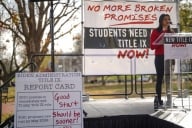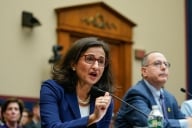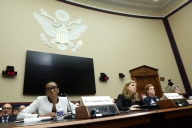You have /5 articles left.
Sign up for a free account or log in.
WASHINGTON -- As Education Department officials fan out across the country to hear feedback on the administration’s proposed college rating system, the associations that represent colleges are starting to stake out firmer stances against some parts of the plan.
After offering a relatively restrained response early on, higher education associations are beginning to more clearly articulate their concerns about the administration’s ratings plan, even though it’s still not clear what such a ratings system will look like. President Obama in August proposed that colleges be rated based on metrics measuring their affordability, accessibility to low-income students, and student outcomes. The administration plans to publish those college ratings by the 2015 academic year and eventually persuade Congress to allocate federal student aid based on how institutions perform.
The department holds the last of its four public hearings Thursday at Louisiana State University at Baton Rouge. But officials have been meeting privately with student advocates, college presidents and other stakeholders.
The leaders of private nonprofit colleges gathered in here last week, in part, to map out their response to the proposed ratings system and meet with department officials.
David Warren, president of the National Association of Independent Colleges and Universities, said the college presidents on his board were in agreement in principle with the administration’s goals but took exception to a federal ratings system.
“We are strongly requesting that the president and department rethink having a federal value metric,” Warren said in an interview. “We’re encouraging them to see if there isn’t another way to get after these shared values of affordability, completion, and accountability.”
Warren said that private college leaders would be willing to work with the department to find ways to provide better information to students choosing colleges, citing NAICU’s U-CAN database as a model.
But, he said, they would be opposed to the government emphasizing some pieces of information over others or combining data points into a single rating in an attempt to identify colleges that offer better “value.”
“Value ought not be determined by the department,” Warren said.
David Maxwell, the president of Drake University, who sits on the NAICU board and attended a meeting with Education Department officials last week, said it’s legitimate for the government to ask what it’s getting for its $150 billion investment, through loans and grants, in higher education each year. But, Maxwell said, a federal rating system wouldn’t provide that type of accountability and would instead impede student choice.
“The real concern is that different students find different value in their college education,” he said, emphasizing that government shouldn’t interfere with students' choices by assigning ratings to colleges based on its own definition of value.
Public universities, meanwhile, have so far taken a less firm stance on the ratings system, but have been generally more supportive of the concept of linking student aid to performance metrics in some cases.
At a public hearing on the rating system, Peter McPherson, president of the Association of Public and Land-grant Universities, told department officials that they should use better data than the government already collects on employment, graduation rates and loan repayment rates (as opposed to default rates) in judging whether institutions should be eligible for student aid. He also proposed weighting those metrics with a “student readiness index.”
“It’s not fair or reasonable really, to rate institutions on their performance without consideration of the nature of their student body,” he said in prepared remarks. “An open-admission school as opposed to a very selective school will have very different outcomes.”
Institutions that perform poorly under those metrics, after accounting for the student population, should lose eligibility or partial eligibility for student aid, McPherson said. On the other hand, he added, institutions that both perform well on the metrics and also enroll substantial numbers of Pell recipients should be rewarded with increased funding.
The APLU is also urging the department to consider using the Student Achievement Measure, a voluntary data system that the group developed in partnership with five other higher education associations, as a model for better data. The Student Achievement Measure, for instance, accounts for a wider swath of students in tabulating graduation rates than the official federal graduation rate, which is based on full-time, first-time students, who are relatively small shares of the student body at many institutions.
The limitation of the Education Department’s data has frequently been raised by colleges and universities as a concern as the administration develops a data system.
In discussing the ratings plan, the two community college associations last week both announced their support for a student unit record data system that would be able to track students across institutions and into the workforce. Both the American Association of Community Colleges and the Association of Community College Trustees said that they would urge Congress to reverse the ban on such a database.
The APLU has also called for “a limited student unit record data system with appropriate privacy safeguards.”
David Baime, the senior vice president for government relations and research at AACC, said that organization didn’t take a position on the ban on such a database when it was inserted into the Higher Education Act at the insistence of other higher education lobbying groups. But, he said, the group now strongly supports it, though recognizes the need to ensure student privacy.
“We feel there’s an imperative for some kind of national database to track students throughout higher education and preferably link to earnings information,” he said. “In theory other entities could undertake that, but in practice it’s difficult to conceive.”
Community colleges, while supportive of a student unit record, have also expressed concerns about the college rating system, and especially linking it to federal student aid.
Advocates for two-year institutions have said they’re concerned that a ratings system would cut off access to the low-income populations they tend to serve. In addition, they have questioned the utility of such a ratings system even for informational purposes since most community college students choose an institution based on its geographic location, rather than other published metrics.
Education Secretary Arne Duncan has said he’s aware of the potential pitfalls of a ratings system. The rating system, he says, will compare only similar institutions and will take into account differences in student populations. Duncan has also dismissed -- somewhat pointedly, at times -- criticism of a ratings system that does not yet exist as premature. That’s a message that one of his deputies, Jamienne Studley, reiterated in remarks Wednesday at a Capitol Hill event, saying that the department was genuinely interested in using public feedback to inform the development of the ratings system.
"There is no secret document, as far as I'm aware, that's behind our backs,” said Studley, the deputy undersecretary of education.
She said that colleges could have their performance in the rating system weighted by mission and the relative preparation of the students they serve, similar to the way a judge at a diving competition would factor in the technical difficulty of a dive in addition to its execution.








